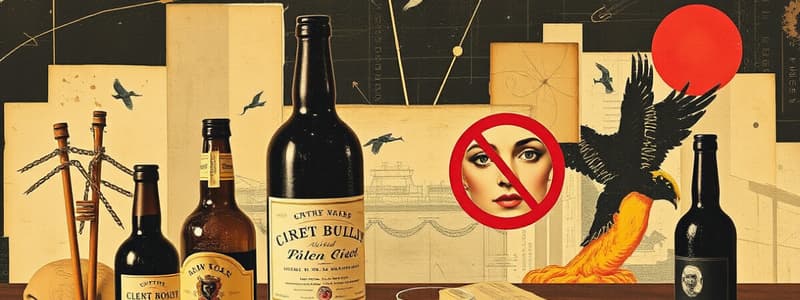Podcast
Questions and Answers
What legislation officially defined intoxicants during the Prohibition Era?
What legislation officially defined intoxicants during the Prohibition Era?
- Temperance Act
- Volstead Act (correct)
- 18th Amendment
- National Liquor Control Act
Which two organizations were key supporters of the prohibition movement?
Which two organizations were key supporters of the prohibition movement?
- Sons of Temperance and Women's Suffrage Association
- Anti-Saloon League and Woman's Christian Temperance Union (correct)
- Anti-Saloon League and National Organization for Women
- Women's Christian Temperance Union and Temperance Brigade
What term was used for individuals or states that opposed Prohibition?
What term was used for individuals or states that opposed Prohibition?
- Saloons
- Drys
- Wets (correct)
- Blind Tigers
What was one reason why public opinion started to turn against Prohibition?
What was one reason why public opinion started to turn against Prohibition?
What amendment was passed to repeal Prohibition in America?
What amendment was passed to repeal Prohibition in America?
Flashcards are hidden until you start studying
Study Notes
Prohibition Era Overview
- Prohibition lasted from 1919 to 1933, prohibiting the transport and sale of alcohol in the United States.
- Established by the 18th Amendment, enforced through the Volstead Act (National Prohibition Act), which was initially vetoed by President Wilson but later passed by Congress.
- The Volstead Act officially defined intoxicants, clarifying what constituted illegal substances.
Support and Opposition
- Prohibition was largely supported by those living south of the Mason-Dixon Line and west of the Mississippi River.
- Major organizations advocating for prohibition included the Anti-Saloon League and the Woman's Christian Temperance Union.
- These groups shifted their focus from individual temperance to advocating for a national ban on alcohol, citing concerns over productivity, military discipline, and family stability.
Terminology
- States in favor of prohibition were referred to as "dries," while opponents were termed "wets."
Illegal Activities
- Speakeasies emerged as illegal bars that served bootlegged alcohol, catering to select patrons during the Prohibition Era.
Growing Discontent
- Over time, increasing public discontent about prohibition emerged, particularly among working-class men and groups like The Women's Organization for National Prohibition Reform.
- Arguments against prohibition focused on rising underage drinking, government regulation issues, declining national revenue, and an increase in organized crime.
Repeal of Prohibition
- The negative impacts of prohibition, including strong resistance and insufficient funding for enforcement, led to the eventual repeal of the 18th Amendment.
- The 21st Amendment was passed in 1933, officially ending the Prohibition Era in America.
Studying That Suits You
Use AI to generate personalized quizzes and flashcards to suit your learning preferences.




